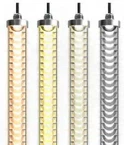Low-voltage busways are revolutionizing modern electrical systems with their advanced heat dissipation capabilities, a critical advantage over traditional cables. Here's why this feature makes them indispensable for industrial, commercial, and infrastructure projects:
1. Innovative Heat Dissipation Design
Low-voltage busways utilize a "sandwich" structure where conductors are tightly enclosed within a metal casing (steel or aluminum alloy). This design leverages air convection and direct heat transfer through the casing to efficiently dissipate heat13. Unlike cables, which rely on insulating materials that trap heat, busways maintain lower operating temperatures even under high current loads.
Technical Insight:
Cable Limitations: Cables' insulation acts as both electrical and thermal insulation, forcing strict limitations on installation layers (e.g., maximum 2 layers in cable trays)13.
Busway Efficiency: Air gaps between conductors and the metal casing allow heat to escape rapidly, reducing the risk of overheating and extending system lifespan16.
2. Enhanced Safety and Reliability
Excessive heat is a leading cause of electrical failures. Busways' superior thermal management ensures:
Lower Operating Temperatures: Typical temperature rise is limited to 30K for metal casings and 40K for internal insulation, far below critical thresholds6.
Fire Resistance: The non-combustible metal casing prevents fire propagation, even in extreme conditions (tested up to 1050°C for fire-rated busways)18.
3. Higher Overload Capacity
Busways use high-temperature-resistant insulation materials (e.g., radiation-crosslinked PER tape rated for 140°C), enabling sustained operation under heavy loads without degradation13. In contrast, standard cables (rated for 95–105°C) face rapid aging and capacity limitations3.
4. Space-Saving and Maintenance-Free
Compact Design: Busways require 50% less space compared to equivalent cable bundles, ideal for constrained environments like data centers or high-rise buildings79.
Minimal Maintenance: High-strength bolts (e.g., grade 8.8) eliminate the need for periodic tightening, while corrosion-resistant aluminum alloy casings reduce upkeep costs37.
5. Real-World Applications
From skyscrapers to renewable energy plants, low-voltage busways excel in scenarios demanding high current (up to 6300A), long-term reliability, and safety compliance16. For example, in a recent solar farm project, busways reduced energy loss by 15% compared to traditional cabling, thanks to their lower impedance and efficient heat management4.
Upgrade to Low-Voltage Busways-where cutting-edge thermal engineering meets unmatched durability. Contact us to optimize your power distribution system today!
Learn more about our fire-rated and modular busway solutions →







